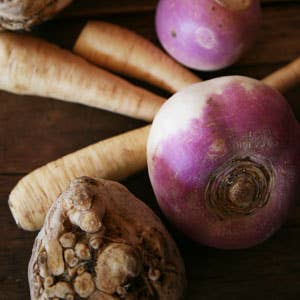
Underground Treasures
The greens of spring may still be weeks away, but something magical is happening below the garden’s surface.
While we eagerly await the arrival of spring's delicious harbingers, like asparagus and rhubarb, a few unassuming but inspiring root vegetables are taking advantage of the lingering cold by growing sweet and tender. So, grab them while you can; they may not be the prettiest in the pack, but these oft overlooked side dishes deserve some early-spring attention.
Celeriac
This homely vegetable, also called celery root or celery knob, has a crisp texture with notes of licorice, lemon, and, of course, celery—but without the fibrous texture. Not commonly used in the United States, this warty wonder is found in abundance on Parisian menus and is the best known for its role in the cold French salad celeri remoulade. Related to anise, parsley, fennel, and carrot, celeriac grows year-round, though its peak season is from November through April. Serve it mashed, fried, or as part of a gratin, and look for orbs that are the size of a baseball; they are more tender and have a less woody character.
Jerusalem artichoke
Who named these tubers, which are neither from Jerusalem nor look like artichokes? We did a little investigating to find out. The most compelling theory we could dig up suggests that the name "Jerusalem" derives from girasole, the Italian word for sunflower—which makes sense, given that this native American vegetable is a member of the sunflower family. Also known as sunchoke or sun root, the sweet and nutty jerusalem artichoke does resemble an artichoke heart in taste and texture and is crunchier than a potato. They can be eaten raw, stir-fried, baked, steamed, or, as we often do, boiled for a warm salad of radicchio and bacon.
Parsnip
Full of starch and sweeter than its carrot cousin, this white beauty loves the cold. Cultivated since ancient times, it was considered an aphrodisiac by the Romans, used as a sweetener in the Middle Ages, and even served as the base of a beer beloved of Irish cottagers. Though not native to the United States, it has a long history here, having hitched a ride across the Atlantic with 17th-century colonists, who used it mainly as a vegetable side dish or an addition to soups and stews. Parsnips can be eaten raw, boiled, mashed, or, our favorite, honey-roasted. In the north, March and April are peak picking times; be sure to select specimens that are small to medium in size with firm flesh and no dark spots.
Rutabaga
Poor, unloved rutabagas: once branded the vegetable of war and the Depression, they bear a name that alone conjures up feelings of antipathy, even in those who have never tasted them. They haven't always had such a grim reputation, though; before pumpkins were available in the UK and Ireland, rutabagas were hollowed out and carved into jack-o'-lanterns.
Thought to have originated in a hybrid of turnip and wild cabbage, rutabagas taste both sweet and bitter. They can be mashed, baked, and boiled, but we especially like them roasted, as in our recipe for rutabaga caponata. When choosing a specimen, remember: the smaller, the sweeter, and make sure your selection is smooth and unblemished. Rutabagas are usually sold with a wax coating to prevent moisture loss; remove it with a knife or a vegetable peeler before you cook them.
Keep Reading
Continue to Next Story










